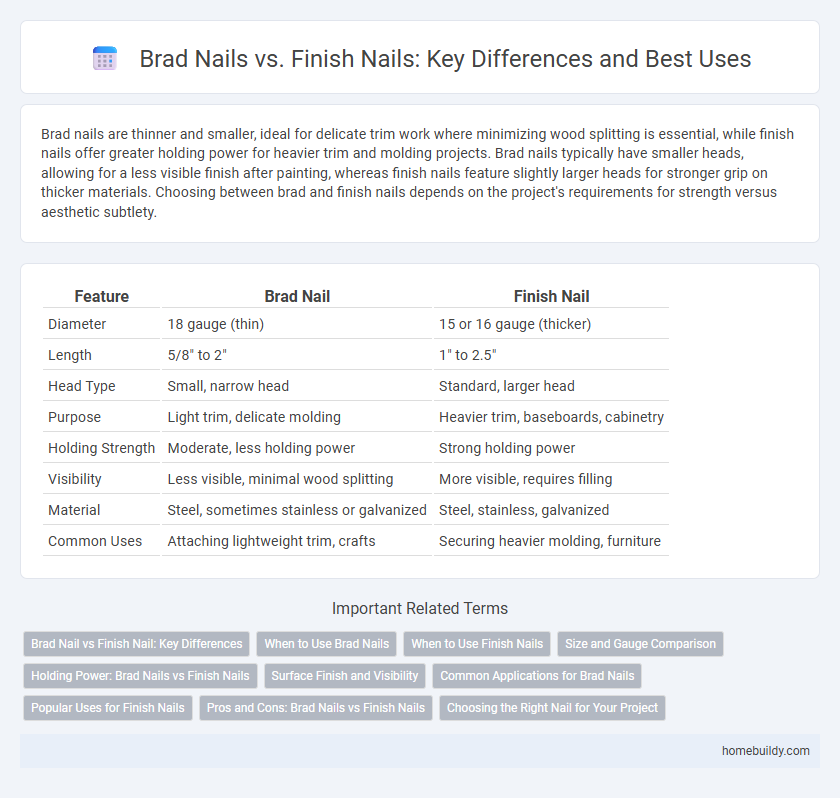Brad nails are thinner and smaller, ideal for delicate trim work where minimizing wood splitting is essential, while finish nails offer greater holding power for heavier trim and molding projects. Brad nails typically have smaller heads, allowing for a less visible finish after painting, whereas finish nails feature slightly larger heads for stronger grip on thicker materials. Choosing between brad and finish nails depends on the project's requirements for strength versus aesthetic subtlety.
Table of Comparison
| Feature | Brad Nail | Finish Nail |
|---|---|---|
| Diameter | 18 gauge (thin) | 15 or 16 gauge (thicker) |
| Length | 5/8" to 2" | 1" to 2.5" |
| Head Type | Small, narrow head | Standard, larger head |
| Purpose | Light trim, delicate molding | Heavier trim, baseboards, cabinetry |
| Holding Strength | Moderate, less holding power | Strong holding power |
| Visibility | Less visible, minimal wood splitting | More visible, requires filling |
| Material | Steel, sometimes stainless or galvanized | Steel, stainless, galvanized |
| Common Uses | Attaching lightweight trim, crafts | Securing heavier molding, furniture |
Brad Nail vs Finish Nail: Key Differences
Brad nails are thinner and smaller, typically 18-gauge, making them ideal for delicate trim work and preventing wood splitting. Finish nails are thicker, usually 15 or 16-gauge, providing greater holding power for heavier moldings and cabinetry. The key differences include nail size, head design, and application strength, with brad nails offering less surface damage and finish nails delivering stronger joints.
When to Use Brad Nails
Brad nails, typically 18-gauge, excel in delicate woodworking tasks such as attaching thin trim or molding without splitting the material. Their smaller diameter leaves less visible holes, making them ideal for detail work where appearance matters. Use brad nails when fastening lightweight materials to achieve a clean, professional finish without the need for heavy holding power.
When to Use Finish Nails
Finish nails are ideal for delicate woodwork and trim applications where a smooth, nearly invisible finish is essential. Their smaller heads allow them to be countersunk easily and filled, making them perfect for cabinetry, molding, and furniture assembly. Use finish nails when appearance and minimal surface damage are priorities compared to the larger heads of brad nails.
Size and Gauge Comparison
Brad nails typically measure 18 gauge and range from 5/8 inch to 2 inches in length, making them ideal for delicate trim and lightweight molding. Finish nails are generally thicker at 15 or 16 gauge and vary from 1 inch to 2.5 inches, providing greater holding power for heavier carpentry tasks. The smaller diameter of brad nails minimizes wood splitting and surface damage, while finish nails offer enhanced strength for structural applications.
Holding Power: Brad Nails vs Finish Nails
Brad nails feature smaller diameters, typically ranging from 18 gauge, resulting in slightly less holding power compared to finish nails, which usually measure 15 or 16 gauge with a thicker shaft designed for stronger grip in wood. Finish nails' larger size and heavier gauge provide superior holding strength, making them ideal for heavier trim, cabinetry, and baseboards where durability and secure fastening are critical. While brad nails minimize wood splitting and surface damage, their reduced holding capacity limits their use to lighter, delicate trim work and smaller moldings.
Surface Finish and Visibility
Brad nails typically have a smaller head and thinner gauge, resulting in less surface finish disruption and minimal visibility once driven into the material, making them ideal for delicate trim work. Finish nails feature a slightly larger, more pronounced head that remains visible and requires filling or sanding for a smooth surface finish on projects with moderate nail exposure. The choice between brad and finish nails hinges on balancing holding strength with the desired aesthetic appearance regarding surface finish and nail visibility.
Common Applications for Brad Nails
Brad nails are commonly used in delicate woodworking projects such as cabinet assembly, trim work, and molding installation due to their smaller size and reduced likelihood of splitting thin or fragile materials. They provide a subtle fastening option for attaching lightweight components where appearance matters because brad nails leave minimal nail holes that require less filling and finishing. Ideal for securing small trim pieces, brad nails ensure a clean, professional look in fine carpentry and furniture making.
Popular Uses for Finish Nails
Finish nails are commonly used in woodworking projects where a smooth, professional appearance is essential, such as installing trim, molding, and cabinetry. Their thinner gauge and smaller head make them ideal for fastening delicate materials without splitting or damaging the surface. Finish nails are preferred for interior projects that require minimal filling and sanding to maintain an aesthetically pleasing finish.
Pros and Cons: Brad Nails vs Finish Nails
Brad nails offer a thinner gauge, making them ideal for delicate trim and preventing wood splitting, while finish nails provide stronger holding power suited for heavier molding and structural trim. Brad nails typically require less filling due to smaller holes, but they lack the durability needed for load-bearing applications compared to thicker finish nails. Choosing between brad nails and finish nails depends on the balance between aesthetic subtlety and structural strength required for the project.
Choosing the Right Nail for Your Project
Choosing the right nail for your project depends on the material and desired finish; brad nails, typically 18-gauge, offer a thinner diameter ideal for delicate trims and preventing wood splitting. In contrast, finish nails, usually 15 or 16-gauge, provide greater holding strength for molding and larger woodwork where durability is essential. Understanding nail gauge and application ensures optimal results in fastening wood surfaces securely without compromising aesthetics.
Brad Nail vs Finish Nail Infographic

 homebuildy.com
homebuildy.com